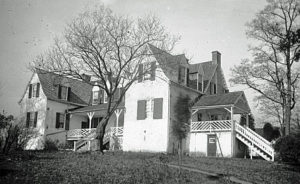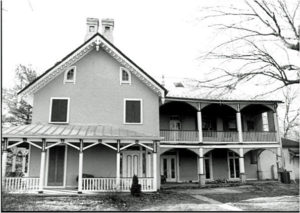The Immaculate Collection: Clairvaux & San Marino
by “My Father’s Son”
“As spring came on, the desire to move obsessed me, and Walter suggested our moving to the ‘Old Dominion,” wrote Louise Closser Hale for Harper’s Magazine 1916 Vol. 133. A bitter New York City winter led Mrs. Hale to agree such an outing was necessary; her restlessness reason enough to travel, while Mr. Hale used the trip as justification to purchase a new motorcar. As Louise Closser Hale, a Broadway actress and writer, packed for the trip, her husband, Walter Hale, a talented artist and Broadway actor/writer himself, took pet-dog “Toby” to test different automobile makes. The couple enthusiastically crossed the Mason-Dixon Line by way of the “Emmitsburg Road” days after departing their 27 N. Washington Square apartment—a seven-story limestone building, adjoining a row of red-brick Georgian mansions. This route was chosen by Walter’s desire to visit his “Uncle Charlie’s” home, bringing the Hales to a lavish collection of homes in Frederick County’s elder land. Pun intended, the Hale’s reached the bounds once belonging to William Elder and wife, Jacoba Clementina Lyvers.
Elder came to the tract “Ogle’s Good Will” on the eastern face of the Catoctin Mountain range’s “Carrick’s Knob” from St. Mary’s County in the early 1700s. The base of the tract was renamed “Pleasant Level,” where Elder constructed the family home, satisfied by the surprisingly flat (or pleasantly level) land at the mountain’s base, necessary for his plantation needs. A devout catholic, Elder named his holdings beyond Pleasant Level, “St. Mary’s Mount,” in homage to his Eastern shore roots and religious interests. The Elders gave part of St. Mary’s Mount to be used as a Catholic College & Seminary in 1808; deemed Mt. St. Mary’s after the land it was erected upon. Pleasant Level was located south of Emmitsburg on the Northeast corner of modern day Motter’s Station Road’s intersection with U.S. Route 15. William Elder’s son, Aloysius, inherited his father’s Pleasant Level property and willed it to Mt. St. Mary’s College (MSM) to preserve the family cemetery sited with the Elder home, and ensure his family’s continued burial there. Aloysius and Josephine Green Elder’s daughter, Ann Rosetta Elder, and husband, James Cretin, resided at Pleasant Level under its MSM ownership with their daughter Mary William Anna Cretin.
Ann Rosetta died at age thirty-seven, and James Cretin remarried Mary Ann Lyvers (likely a descendant of his first wife’s paternal Grandmother, Jacoba Lyvers’ original lineage.)
“We turned off the highway to go to “Uncle Charlie’s,” following an avenue of huge pear-trees out for Easter that must have been centuries old,” Mrs. Hale described approaching the estate called “San Marino.” In 1916, San Marino was owned by Daniel F. Roddy, presuming him the “cordial host” who greeted the city folk. Roddy purchased San Marino from Jonas V. Summers and wife, Frances Eleanor Joy, in March of 1900. Five years prior, the Summers’ had bought the place at a public sale from Charles Augustus Manning and son, Edward Tiers Manning.
Charles A. Manning’s mother was Sarah Ann Schenk Timberlake Manning, first married to Lewis Timberlake. Virginia Timberlake Hale—Walter Hale’s mother— resulted from Ms. Schenk’s first marriage, making Charles Manning the younger half-sibling to Virginia and, therefore, Walter’s “Uncle Charlie.” In 1857, Charles Manning and New Yorker Edward William Tiers joined Joshua Shorb in shared ownership of the San Marino property. It appears that Shorb was then bought-out by the partners, a conveyance then reassigned solely to Tiers. Manning forwent his share of San Marino to Tiers in trust that the continued use of the property and premises be retained for him and his wife for the extent of their natural lives. Manning’s wife, Emily, was Edward Tiers’ daughter, making the gentlemen’s arrangement easier to understand between father and son-in-law. Also agreed were the stipulations that in the event of the Mannings’ deaths, the “rents and profits” of the estate would be given to “support or maintenance the child or children of Emily Tiers Manning until the age of twenty-one is reached.”
Built circa 1780 by one of Pleasant Level’s Elder sons, San Marino, was a well-outfitted estate, down a drive opposite what is today Mechanicstown Road. In addition to the main house were a smokehouse, stone outbuildings, and a two-room privy with lathed wall between a multi-seat out-house and bathing room, utilizing water drawn from Beaver Branch, on whose banks the privy was built.
From San Marino, described as “one of the show places of the northern part of Frederick County,” Roddy operated a Lime Kiln and quarries for over forty years, providing stone used to build the first great roads of Maryland. Maryland and Pennsylvania agricultural regions benefitted from Roddy’s shipments of prime lime. Roddy’s kilns stood on the border of the San Marino property, along the road that would become “Old Kiln Road,” connecting the Motter’s Station road to that of Roddy’s childhood, aptly named “Roddy Road.”
Just as San Marino was built by William Elder’s son, its land, too, was from William Elder, conveyed away from Pleasant Level after MSM sold Dr. James Aloysius Shorb the land left them by Aloysius Elder against his Will. James Shorb was an Emmitsburg physician and original student of MSM, whose purchase of “part of St. Mary’s Increase” contained both the homes San Marino and Pleasant Level. In 1853, Shorb sold the 200-acre San Marino property as a means to “settle a debt” with Emmitsburg Master Carpenter Joshua Shorb. San Marino was noted as containing “an elegant brick dwelling,” where Dr. Shorb’s family first lived. James Debarth Shorb, the son of Dr. and Margaret McMeal Shorb, controlled thousands of acres in Southern California during adulthood. He was first to use pipes there for irrigation and designed the city of San Gabriel’s water-supply system. In this vicinity, James DeBarth Shorb established the towns of Alhambra and San Marino, a town of expansive homes named after his 1841 birthplace. Joshua Shorb embellished the San Marino dwelling with Gothic Revival architectural elements. It is believed that Joshua always resided in Emmitsburg and never lived at San Marino.
Haled by its intricate architecture, the second stop by the Hales was to San Marino’s neighboring estate, the Gothic mansion “Clairvaux.” Dr. James Shorb reportedly constructed the Greek-Revival, Normanesque chateau Clairvaux at Pleasant Level, around 1850, probably completed and inhabited by the Shorbs near 1853 (the year they sold their former residence, San Marino.) The construction of Clarivaux may have been the craftsmanship of Joshua Shorb (listed as having the largest and most successful wood carpentry business in Emmitsburg at the 1860 Census.) Clairvaux’s construction could also have been the source of the debt settled between the doctor and carpenter with the San Marino property. The former Elder home allegedly stood nearby Clairvaux until 1862.
Shorb’s sale of Clairvaux eventually allowed the Cretin family to reclaim the property, whose 1876 deed called it “the rest and residue of the real estate specified and described in a deed from the President and council of Mt. St. Mary’s College to a certain James Shorb.” After thirty-three years, John Cretin’s wife, Emily, sold Clairvaux to neighbor Daniel F. Roddy, whose heirs sold to Marie Gloninger Rial in 1940, with inclusive water rights to Wolf’s spring and reservoir and “piping to mansion as done by John T. Cretin.”
The abandoned Clairvaux mansion was engulfed by inextinguishable fire in the 1970s that could only be left to burn itself out. Two earlier fires at Clairvaux claimed a summer home and barn. In 1986, MSM, who again took ownership of the property when Marie Rial’s family sold to the seminary in 1978, demolished the ruinous, stately brick walls left by the fire. Like other historic farms in the area, all structures of the San Marino property—Roddy-era lime kilns included—have been more recently demolished under ownership of Kline Farm Properties LLC. The fenced Elder graveyard remains today visible from Motter’s Station Road, a parcel preserved under MSM ownership since Aloysius Elder’s conveyance.
Walter Hale died of Cancer in 1917. Louise relocated to Hollywood in 1929, where she appeared in a large amount of movies over a short time before her death in 1933. A book, We Discover the Old Dominion, was published by Mrs. Hale, also containing illustrations by Walter Hale, one being of the Emmitsburg Clairvaux Mansion with his new roadster in front.
Follow remembering_frederick on Instagram for more Frederick County History and photographs.
Courtesy of Beck Images

The Normanesque chateau “Clairvaux” constructed at Pleasant Level by Dr. James A. Shorb.
Courtesy of Maryland State Archives

The San Marino Farmhouse, constructed south of Mt. St. Mary’s University, the longtime home to prominent citizen Daniel F. Roddy.

